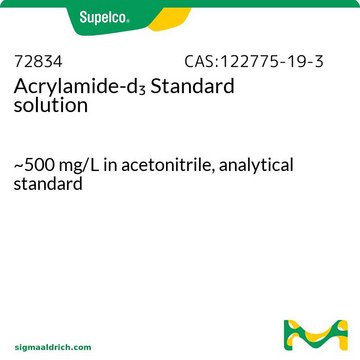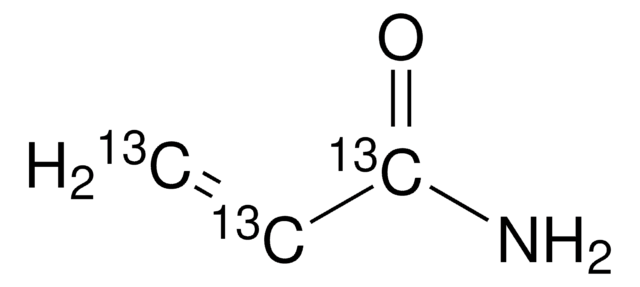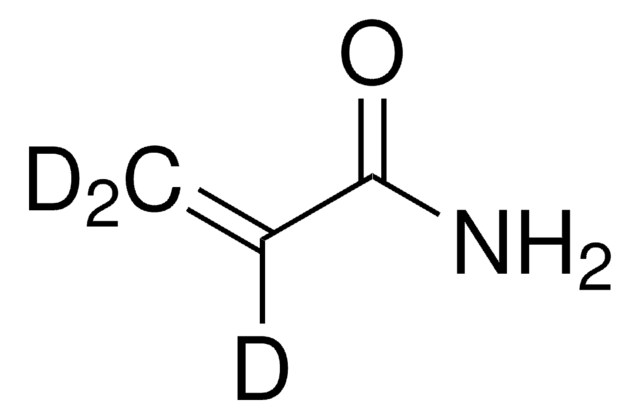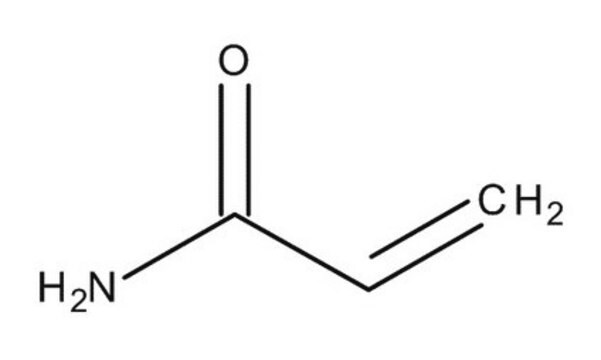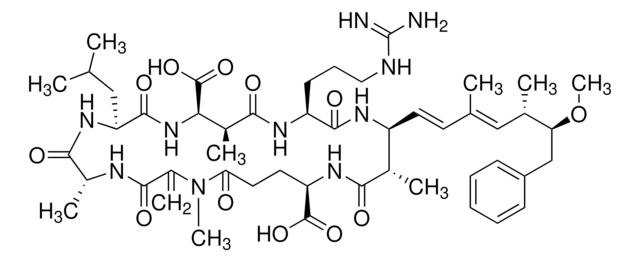Kluczowe dokumenty
08267
Acrylamide
certified reference material, TraceCERT®, Manufactured by: Sigma-Aldrich Production GmbH, Switzerland
Synonim(y):
2-Propenamide, Acrylic acid amide
About This Item
Polecane produkty
klasa czystości
certified reference material
TraceCERT®
Poziom jakości
gęstość pary
2.45 (vs air)
ciśnienie pary
0.03 mmHg ( 40 °C)
producent / nazwa handlowa
Manufactured by: Sigma-Aldrich Production GmbH, Switzerland
metody
HPLC: suitable
gas chromatography (GC): suitable
tw
125 °C/25 mmHg (lit.)
mp
82-86 °C (lit.)
Zastosowanie
cleaning products
cosmetics
environmental
food and beverages
personal care
format
neat
ciąg SMILES
NC(=O)C=C
InChI
1S/C3H5NO/c1-2-3(4)5/h2H,1H2,(H2,4,5)
Klucz InChI
HRPVXLWXLXDGHG-UHFFFAOYSA-N
Szukasz podobnych produktów? Odwiedź Przewodnik dotyczący porównywania produktów
Opis ogólny
Certified content by quantitative NMR incl. uncertainty and expiry date are given on the certificate.
Download your certificate at: http://www.sigma-aldrich.com.
Zastosowanie
- Advanced Synthesis Techniques: Acrylamide is utilized in the synthesis of acyl cyclopentaquinolinones, showcasing its versatility in heterocyclic scaffold construction and acyl group introduction, proving essential for organic synthesis in pharmaceutical research (Xue et al., 2024).
- Material Development for Energy Sectors: Acrylamide-based polymers are applied in developing temperature-sensitive materials for oil and gas drilling, highlighting its importance in creating responsive materials for challenging environments (Yang et al., 2024).
- Innovations in Polymer Science: The use of acrylamide in the numerical simulation of polyacrylamide hydrogel via thermally initiated frontal polymerization provides insights into the controlled synthesis of hydrogels, useful in biomedical applications (Yi et al., 2024).
- Health Impact Studies: Research includes acrylamide in studies examining the inhibition of harmful Maillard reaction products by polyphenols, relevant for understanding chronic diseases linked to dietary acrylamide (Ye et al., 2024).
Opakowanie
Polecane produkty
Informacje prawne
Hasło ostrzegawcze
Danger
Zwroty wskazujące rodzaj zagrożenia
Zwroty wskazujące środki ostrożności
Klasyfikacja zagrożeń
Acute Tox. 3 Oral - Acute Tox. 4 Dermal - Acute Tox. 4 Inhalation - Carc. 1B - Eye Irrit. 2 - Muta. 1B - Repr. 2 - Skin Irrit. 2 - Skin Sens. 1 - STOT RE 1 Oral
Organy docelowe
Peripheral nervous system
Kod klasy składowania
6.1C - Combustible acute toxic Cat.3 / toxic compounds or compounds which causing chronic effects
Klasa zagrożenia wodnego (WGK)
WGK 3
Temperatura zapłonu (°F)
280.4 °F - closed cup
Temperatura zapłonu (°C)
138 °C - closed cup
Wybierz jedną z najnowszych wersji:
Masz już ten produkt?
Dokumenty związane z niedawno zakupionymi produktami zostały zamieszczone w Bibliotece dokumentów.
Klienci oglądali również te produkty
Protokoły
HPLC Analysis of Acrylamide and Acrylic Acid on Discovery® HS F5
Nasz zespół naukowców ma doświadczenie we wszystkich obszarach badań, w tym w naukach przyrodniczych, materiałoznawstwie, syntezie chemicznej, chromatografii, analityce i wielu innych dziedzinach.
Skontaktuj się z zespołem ds. pomocy technicznej
